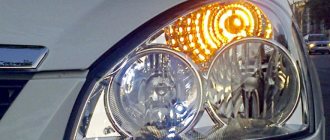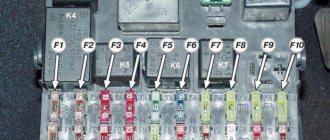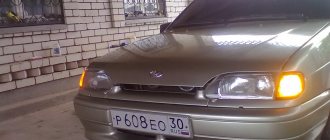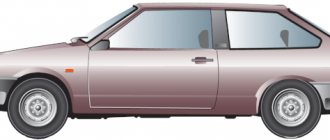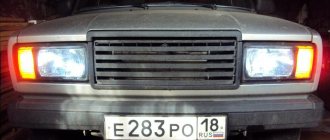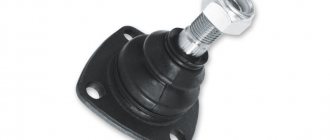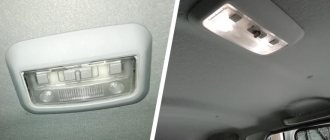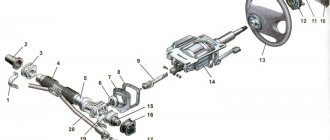Signs and causes of malfunctioning turn signals and emergency signals
These elements of the lighting system stop working due to:
- Blown fuse box in the passenger compartment. This problem occurs often. If the car is equipped with a relay that regulates the operation of lighting devices, the cause should be looked for in it. Depending on the make of the car, this part may be located at different distances from the fuses. The diagram attached to the instructions helps you find it.
- Short circuits in the on-board network. Because of this, the turn lights do not light up and the hazard warning lights go off instead. The system stops responding to user commands. To detect a breakdown, you will need a multimeter. The driver must understand the electrical circuit.
- Failure of the lighting source. In this case, replace the burnt out light bulb.
- Broken wiring. This is what owners of outdated VAZ car models face. If the wires are laid in places where there are moving parts, the braid will fray over time. The integrity of the electrical circuit section is compromised.
- Failure of the turning light control element or steering column switch. In this case, a thorough diagnosis of the control buttons is required.
The following signs help determine the presence of malfunctions in the optical system of the machine:
- The turn signals are on continuously. The symptom appears when the relay breaks down, in particular its electromagnetic component. It often gets stuck in one position, causing it to be unable to return to its original position.
- The blinking frequency of the turning lights has changed. The source of this malfunction is not only the relay, but also the wrong type of light bulb. When purchasing new lighting products, take into account the value declared by the car manufacturer.
- The optical system is not functioning. Not only the lights do not light up, but also the indicators on the center console. The clicks that occur when the indicators are turned on are not observed. There are many reasons for such malfunctions.
Fuses and relays in Lada Granta, electrical diagrams
If you bought a Granta and started having electrical problems, you may be faced with a manufacturing defect. But don’t be alarmed ahead of time, the first thing you need to do is check the fuses and relays in the Lada Granta and find out the cause of the malfunction. If you're lucky, you'll get away with simply replacing the fuse.
If not, you may have to go to a car service center or troubleshoot the electronics yourself. Remember - the main thing in such cases is to fully understand the problem, do not waste time on this, because any car owner should know as much as possible about his car (especially a domestic one).
Checking the relay
Where is the Grant turn signal relay located? Everything is in the same mounting block. Marking K5.
How to replace the turn signal relay on a Lada Grant? It can be removed using a puller located in the mounting box, and then a known-good unit can be placed in the free space. If everything works with the new relay, then the problem is solved. However, even before searching for a burnt-out lamp, you can check the Lada Granta turn signal relay.
If you are faced with the fact that the turn signals on your Grant are constantly on, then this probably indicates that something is shorting somewhere. You need to test the circuit with a multimeter. Sometimes in this case it is possible to establish the influence of emergency lights and even signaling. Remember if you changed anything there before the problems with the turn signals appeared.
Another common problem is the situation when the turn signals on a Lada Granta do not work, but the emergency lights do work. It is necessary to check whether everything is in order with the emergency button. It happens that the button simply moves away. It needs to be given a normal position, and the turn signals will work.
Causes of direction indicator malfunctions
- Failure of the steering column switch.
- Damage to the turn signal relay.
- The hazard warning button is faulty.
- Open circuit. If the turn signals do not work on all sides, the first thing to check is the turn signal relay power wires. If the indicators stop working on only one side, the problem is in the wires running from the steering column switch to the light bulbs.
- Oxidized contacts, broken wires. The turn signals do not work if the circuit resistance differs significantly from the nominal value. To supply power, it is necessary to exceed a certain power level of consumers. If the microcircuit inside the turn signal relay does not register sufficient current due to increased resistance, power will not be supplied to the bulbs.
Device
The following are involved in the operation of turn signals:
- steering column turn switch. Its function is to close the power contact of the light bulbs. For example, when you turn the switch up, one of the contacts of the light bulbs on the right side closes to the “+” of the battery. The “minus” of the light bulb is the connection point to “ground” (the common point for all headlight bulbs);
- turn signal relay. There is a regular electromagnetic relay inside the case, but it is controlled by a microcircuit. It is thanks to this element that an intermittent power supply to the coil is ensured. The second important function is monitoring the health of the lamps. The microcircuit has a feedback function, so when a light bulb burns out, it registers a decrease in the power of consumers and begins to supply power to the coil at double the frequency. If the turn signals are working properly, the lights blink approximately once per second. Most modern cars, including VAZ models, use a 3-pin turn signal relay. Accordingly, 1 contact is “ground”, 2 – power supply from the battery, 3 – output to the steering column switch;
- light indication on the dashboard. One or two light bulbs (one on each side) are connected in parallel to the electrical circuit of the main lamps. The turn signals will work without a light indication, so the system should not be considered among the possible causes of the malfunction.
Turn signal diagram
The turn signal circuit differs from the usual one, where a relay and a fuse were used. The function of the turn relay can be performed by the central body electronics unit (CBEC), which is located under the panel next to the ECU. It receives input (negative) signals to contacts (X2-7 and X2-8) from the steering column switches and the hazard warning button. At the output, the TsBKE block forms “pluses” on the contacts (X1-14 and X1-15), which go to the light bulbs in the headlights and lanterns. The clicks of the turn signals are not produced by the relay, but by a buzzer on the unit board.
Headlights
Everyone remembers that driving with faulty lighting devices is prohibited. However, if a partial malfunction occurs, many simply continue driving, hoping that the remaining light will be enough for them. This is a dangerous practice that, in addition to a hefty fine, can cause a serious accident, especially in bad weather.
At this point we are not even talking about the complete loss of functionality of one of the headlights, but, for example, about the gradual loss of transparency of lenses or diffusers, untimely adjustment of the light flux, as well as banal pollution.
Always check the functionality of the lighting devices, especially if you are traveling in the dark or in bad weather, carry out all routine maintenance in accordance with the recommendations, and also if there are only the slightest changes in their operating parameters. Even if it’s snowing or raining, wipe your headlights - this will significantly improve the road illumination for at least a few kilometers of your route.
Why does the turn signal flash three times?
Many car enthusiasts are surprised by the function of car turn signals, thanks to which they always blink three times. It has been around for many years, but not many people know why a triple signal is needed and what its meaning is, which is worth talking about in more detail.
From single to triple. Automakers began using triple turn signals in the early 2000s. The process happened gradually; German models were the first to receive this function, followed by all the others. In 2010, it was already possible to see a new function on Russian cars, and a few years ago the UAZ plant began using similar technology for emergency lights.
When you press the signal, the driver will see a double light, which has already been nicknamed the “polite driver” among motorists.
Why triple signal? The triple signal began to be used because it is convenient to use it when changing lanes, when the movement is almost straight, and automatic switching off of the signal does not work, since the steering wheel does not deviate much to the side. Then the motorist would have to press the “flashing lights” several times, which becomes distracting while driving.
Empirically, during testing, experts came to the conclusion that a triple signal in this situation will be more effective in ensuring that road users see the intentions of the vehicle owner and he can change lanes without problems.
Convenient feature. It is noteworthy that the mandatory use of a triple signal is not stated anywhere, however, due to convenience, most motorists decided to use it. Despite the shortcomings, for example, on LADA models there is only such an opportunity to warn other drivers, but in foreign cars and crossovers there is a function for connecting an on-board computer that regulates the duration of the signal, it is implemented in many situations.
It is noteworthy that modern car models even have a function for selecting the number of signals - from one to five. Some vehicle owners even change the relay settings, but interfering with the factory algorithm does not cause any harm to the car.
Bottom line. Not many drivers know why the turn signal light always flashes three times. It would seem that this function comes naturally in all cars, but this is not the case. Initially, only one light signal was used, but later there were three, and in modern cars five.
This solution allows motorists to quickly find their bearings and change lanes when driving on the road, which clearly confirms the use of technology in all models and the approval of motorists.
Rain is a joy for us. Test drive of Viatti Bosco H/T V-238 SUV tires
See all photo news >>
Self-diagnosis of car lighting devices
There are several situations in which you can determine that optics need diagnostics:
- The turns do not flash, but light up. Such a malfunction indicates the failure of the relay, in particular, we are talking about its electromagnetic component. The electromagnet itself could close in one of the positions, as a result of which it cannot return to its initial state.
- The turning lights flash very quickly or very slowly. In this case, the problem may lie not only in the relay. In some cases, this type of malfunction occurs when the driver uses inappropriate lighting sources. So when purchasing new light bulbs, you need to make sure that they correspond to the rating set by the car manufacturer.
- The optics don't work at all. That is, the turning light bulbs do not flicker, and the corresponding indicators on the dashboard also do not light up. In addition, there are no characteristic clicks that appear when turning on the turning lights. With such symptoms, there can be many reasons for the problem; we will tell you more about their diagnosis below (the author of the video is the Steel Horse channel).
As for diagnostics, it is performed in several stages:
- First of all, you need to make sure that all sensors and indicators on the device are working. If they do not function, then it is necessary to diagnose the safety devices.
- If all devices are operating in normal mode, then you next need to turn on the light alarm button and diagnose all light sources in the headlights. That is, check the front, rear, and side (if any) lights.
- If the alarm does not function when activated, you need to check the functionality of the relay, and also check the power supply at the terminals. To do this, remove the relay from its mounting location, and then, using a test light, connect one of its contacts to the installation site (to the positive), and the other to the car body or battery. There is no need to turn on the ignition. If there is no power, then most likely the reason lies in a failed safety device, a broken hazard warning button, or a damaged electrical circuit. Also, the essence of the problem may lie in poor contact in the connecting plugs.
- If there is a plus on the contacts, then try shorting the two relay terminals using copper wiring. If all electrical circuits, as well as the connection plugs, are working properly, then all turn signals should light up. In this case, the fault must be looked for in the relay.
- If the lights do not light up after the steps you have performed, then most likely the cause of the malfunction lies in the emergency light control button. However, in practice this happens quite rarely; there is often a short circuit in the circuit. By the way, it is a short circuit that can lead to a breakdown of the relay, therefore, before replacing the failed element, you need to eliminate the short circuit.
- If the emergency signal is functioning, this indicates that the safety devices and relays are working; accordingly, you need to start diagnosing the button itself. First of all, you need to diagnose the positive terminal, as in the case of checking the relay, while the ignition, as well as the hazard warning button, must be activated. If the diagnostics showed that there is no plus, this indicates that the button itself needs to be checked in more detail. Remove it from its seat and check the connection circuit. If there is no power, then you need to look for a break in the wiring from the tidy to the button itself. If there is power, then you will need to short-circuit the terminals at the installation site, the ignition does not turn off, after which you need to activate the direction indicators (on either side). When the lighting sources are turned on, the control button must be replaced, but if there is no power, then you need to check the power in the emergency relay. If there is no power, the problem most likely lies in a break in the connecting electrical circuit from the control key to the block with safety devices.
Video “How to insert diodes into corners?”
Detailed instructions on installing LED elements in this type of optics are presented in the video below (the author of the video is the RECOVER PSR channel).
Well, I got a hack. And for one thing, I’ll write again in my style about what everyone knows. Well, maybe someone doesn’t know.
When > special sores appeared in my life. Plus experience in mastering. I’ll be honest! After the classics it was boring.))) A reliable machine after all... But first of all I got it... Self-turned washers, Solex, and electrics. So I came across something like this with three handfuls of diodes scattered around the car.))) The guy didn’t bother connecting what or why, and it had its effect. But the number nine also has its own personal problems.
A guy contacted me today. That’s why I’m writing, not a rare snot by the way. Briefly speaking:
When the turn signal is on, the high beams come on.
This misunderstanding has many reasons. Namely:
1 _ Check the ground throughout the entire car, even if it looks freshly grounded. 2 _ It’s a good idea to clean under the stud that connects the negative of the battery to the body until white, put a thick washer and tighten it. And fill everything with mavil. 3 _ Make sure that the mounting block is in good working order. 4 _ And check the board in the rear lights, wipe everything with WD-40,
I’m not explaining it in a stupid way, I’m not good at electrical work... In general, I’m not good at it!
But if I had this garbage, I had already figured out everything else, so that was no longer necessary. All that was left was the switch. So today, having licked all the masses and contacts, I moved on to the parts of the switch. It was possible to move on at once, but both the mass and the contacts were like that! The condition was that there were burnouts in many places.
I won’t deprive you of your attention if anyone is interested, and indeed someone might find this useful. So, after removing the switch, I realized that there are two problems here, two of the others that this causes._ 1st: This is the lever axis being triggered
And the main beam contacts do not have a significant gap. It is easily overcome under the tension of the springs and closes
So, after removing the switch, I realized that there are two problems here, two of the others that this causes._ 1st: This is the lever axis being triggered. And the main beam contacts do not have a significant gap. It is easily overcome under the tension of the springs and closes.
You could buy a new one and not worry... But the shops were closed, and tomorrow was a day off, and as you can see, this is a taxi, and for a taxi, Putin is coming. Plus, as I wrote, there was a lot of potology.
That is, the solution... Melt! That is, remove the backlash.
_ 2nd: This is the contact pin - N 56.
Somehow he disappears. . It’s enough to return it to its original position and that’s it. Until you somehow turn it on again. But if you pull it with a harsh hand... It’s enough to remove the steering column cover and release the latches securing the switch, and fix everything again. And understand that you need to be more gentle)))
There may be another incident with this node. Because of some fright, the turn signal stops turning on. If not a mechanic, then there may be an abundance of bronze-containing lubricant.
You can see it in the photo, but if you can’t see it, it’s not difficult to see it by removing the switch. This is the color of tarnish, somehow it gets on the contacts. I removed it all.
After talking, we climbed around Pyatnashka. We discovered a loose timing belt. I wanted to get smart about this. There’s simply no point in buying keys to turn the eccentric, it’s from 40 to 180! Rubles! And sometimes it is disposable, sometimes forgotten in the garage. Sometimes it's just not convenient. You don’t need a key. It might come in handy... It’s not a bad idea to make it a rule to carry a couple of electricians. This is a multifunctional item. This is where it comes in handy. Having made such a bend, we inserted it into the hole and also tightened it with a key. I don’t argue that the electrode is not a hardened rod. But for all its plasticity, it is enough.
But you can’t overtighten the strap!
When overtightening, there is at least a howl, as a result, broken pump bearings. With all the consequences, and premature breakage of the strap itself.
Guys, good morning! There are several questions: 1) the doors no longer open with the button, but close perfectly 2) and when I turn on the turn signals, the high beam lights up. Help me out, please.. VAZ 2112
1)…. (I don’t know) 2) Replacement petal
0 0 Answer rating: 0
If the d/g is 3-pin, then the + wire is broken, and the signaling has caught a glitch, changing the polarity to d/g
0 0 Answer rating: 0
2) replace the switching system. The problem should disappear! I had this happen on a VAZ 12
0 0 Answer rating: 0
2) steering wheel paddle (price 200, 10 minutes of operation)
0 0 Answer rating: 0
Fuses and relays in Lada Kalina, electrical diagrams
Fuses and relays in Lada Kalina, electrical diagrams
If one or another electrical device in your Kalina has stopped working - headlights, low or high beams, cigarette lighter, stove, turn signals, as well as other devices, then the first thing you need to do is find the cause of the malfunction, in particular, check the fuses and relays in the Lada Kalina.
The first thing to check in electrical circuits is the fuses, because they are the weakest point of the circuit and are usually the first to fail. Read on to learn about which fuses do what in the Lada Kalina, as well as where the relays are located and how to find the right one.
If you do not want to get into an unpleasant situation when, due to a blown fuse, one or another device refuses to work, but you don’t have a whole one at hand, it is useful to make it a rule to always carry with you a set consisting of different fuses.
For the Lada Kalina, you can buy a similar set at any auto store that sells auto parts for domestic cars. It takes up very little space, but its benefits in case of failure will significantly reduce your time to fix the problem.
Relay and fuse box
The fuses in the Lada Kalina are located under the dashboard, in a block located to the left of the steering wheel. To get to it, you need to open the cover in which the headlight switch is built in. The lid has latches; if you pull it towards you by the upper part, it will open and fold down (its lower part is fixed on an axis).
F1 (10 A) - immobilizer, dashboard lamps and sensors, reversing light, turn signals. If any of the gauges on your dashboard stop working, or one or all of the warning lights stop lighting up, check that fuse, as well as the gauges or bulbs themselves. If the rear white light does not come on when you engage reverse gear, it could also be this fuse or the reverse switch.
The reverse switch is located on the transmission, to change it you will most likely need to remove the engine cover to get to it. Located on the left side in the direction of travel on the rear of the gearbox.
If the turn signals do not work and this fuse is intact, also check relay K5, the turn signal control knob, its connector, as well as the turn signal lamps themselves.
F2 (30 A) - electric windows. If the power windows stop working, check this fuse, as well as relay K2. If the fuse and relay are good, there could be a number of reasons. First, try pressing the power window button and slamming the door. If the mechanism “bites” when the glass is raised, this may help.
Otherwise, you need to disassemble the casing and look at the mechanism. When disassembling, you need to check the serviceability of the gears and all components of the window lifter, including the motor brushes. It could also be a problem with the power window module. It is located in the left rear door; if there is something wrong with it, then most likely you will have to change this module to a working one.
F3 (10 A) - alarm.
If the emergency lights do not work and this fuse is good, check relay K5.
If your left or right turn signals come on and are constantly on, even when you turn off the ignition, this is a factory defect. In this case, it is necessary to replace the body electronics control unit. This can be done in official salons.
F4 (20 A) - windshield wiper, heated rear window. If the windshield wipers do not work and this fuse is intact, also check relays K4 and K6. The issue may be in the windshield wiper motor or its mechanism. Check the wiper switch and its connector.
If the rear window heating does not work, check fuse F8, the heater terminals, their contacts, as well as the contacts of this fuse and relay K6. Another issue could be poor contact on the body. The wiring ground is connected to the body under the dashboard. If there is poor or oxidized contact in this area, it can also cause problems with the correct readings on the panel instruments.
F5 (25 A) - heater, electric power steering, windshield washer. If this fuse and relay K4 are intact and the stove does not work, the problem may be in its electric motor (brushes) or the power button, as well as its contacts. If the electric power steering does not work, this fuse and fuse F31 are intact, then it is better to contact a workshop, because it will be difficult to find and fix this malfunction yourself.
F6 (20 A) - sound signal.
If this fuse and relay K8 are working, but the signal does not work, check the horn itself. It is located under the front bumper near the radiator. Sometimes it is enough to turn the adjustment screw
vmiredorog.ru
The turns just light up and don't flash.
VAZ (Lada) 2108/2109 1984 - 2006
Why is such a mess going on with turn signals? When I turn on the left ones everything is fine, but when I turn on the right ones I hear a loud squeak and the turns just light up and don’t blink
- Rear turn off 21099 – 2 answers
- The right turn signals of VAZ 21099 do not blink - 2 answers
- The turns and hazard lights of the VAZ 2108 are blinking dimly – 2 answers
- The front right turn signal in the VAZ 2108 does not work - 2 answers
- The side lights blink instead of the turn signal, VAZ 2109 - 2 answers
Check the relay. When you turn on the left turn, the contacts work normally and tap, but when you turn on the right turn, instead of working normally, for some reason the contacts close and rattle, so you hear this squeaking sound. You need to open it up and figure it out, maybe you just replace it, or maybe the reason is external, for example, the contact of some leg is loose
Turn relay No. 11 (unless, of course, you have the old-style mounting block 17.3722)
I had to open the relyushki. You open it, there is carbon deposits on the contacts, you carefully sand it with fine sandpaper, you assemble it, put it in place and it works like new again.
If the relay were faulty, then all the turn signals would be on constantly (I personally experienced this twice). We need to look at the wiring, there is a short somewhere, maybe in the steering column switch. It sounds like the washer is turning on.
- How to replace the hazard warning light in a Honda Civic 7? – 1 answer
- How to remove the panel on the dashboard where the car radio is located in a Honda Civic 7? – 1 answer
- How to remove a generator with a vacuum pump Honda Civic 1.7ctdi? – 0 replies
- Is it possible to fill G12 plus in Honda Civic 7? – 2 answers
- Error P0135 in Honda Civic 7 - 2 answers
- Only the upper part of the Honda Civic 7 interior heats up - 2 answers
- How to install post-restyle headlights on a 7 Honda Civic in the pre-restyle hatchback version? – 1 answer
- How to install PTF on 7 Honda Civic hatchback? – 1 answer
- Where is the fuel filter for Honda Civic 7 located? – 1 answer
- The heater cable breaks in a Honda Civic 7 - 1 answer
Even more useful tips in a convenient format
The front right turn signal in the VAZ 2108 does not work
The turns and hazard lights of the VAZ 2108 are blinking dimly
Replacing the turn relay on Grant
First of all, we find and remove the protective cover of the fuse box (mounting block). To do this, you need to snap off the special latches. It is best to start the removal process from the upper left corner. Pick up the corner of the cover, apply force and remove the fastening clamp from the groove. Pull the decorative element towards you. After all the latches have come out of the grooves, do not make sudden movements or yank the body of the decorative cover. The thing is that there is a trunk opening button on the body, to which a contact chip with wires is attached. Therefore, in order not to damage the contacts and carry out further work, the chip must be disconnected from the button connector. After dismantling the decorative cover, we get free access to the mounting block with fuses and relays
Please note that a special plastic puller is provided for removing fuses, which greatly facilitates the entire process of work. To remove the relay, the mounting block contains the same puller, only of a larger size.
In addition, on the back (inner) side of the decorative cover there is a diagram with detailed identification of all internal components, which is very convenient when working. All elements in the mounting block have their own markings. The product called “K5” is responsible for the operation of turn signals and hazard warning lights. The relays in the block are installed quite reliably and in order to replace them you will need to use some physical force. It is best to dismantle the part using a puller. However, quite often, it is not possible to remove the relay even when using it. The ideal solution for such cases is to use pliers. Reinstalling the cover is a little more complicated than removing it. Don't forget to connect the contact chip to the connector of the rear trunk release button. We recommend starting installation from the bottom right side. Place the rightmost latch into the hole, then do the same with the central and leftmost latch. After that, move to the upper fasteners and carry out similar manipulations. With a simple push, snap the decorative cover onto the panel. This completes the removal and installation process.
https://youtube.com/watch?v=eSW_JQyzuuc
"Important. If the relays in your car are constantly failing, then there is reason to conduct a thorough diagnosis of the corresponding power supply circuit.”
Fuse box under the hood of a car
In the Lada Granta car there is another block of “powerful” fuses under the hood of the car. The fuse rating is from 30A to 60A, which is why this unit is called a power unit.
The fuse box is indicated by an arrow
To access the fuses, pull the protective cover upward. It can be easily removed. After finishing work, do not forget to return the cover to its place.
Block diagram in configurations: Standard, Norma
Block diagram in the Lux configuration
Typical turn signal malfunctions and their elimination
So, for what reasons do the turn signals not light up? Why does the high beam turn on when I turn on the turn signal? What does a frequently flashing light indicate and why can contacts in an electrical circuit short out? The main reasons why turn signals do not work, as well as solutions, are given below.
Car steering switch with emergency lights
Doesn't blink
When the turn signals do not blink when turned on, most likely the essence of the malfunction lies in the breakdown or burnout of the corresponding relay installed in the mounting block. If, when activating the optics, you notice that it can no longer light, then the reason may be a short circuit caused by moisture, or interruption of contact. In this case, it is better to change the contact itself
If replacing the relay does not help solve the problem, pay attention to the integrity of the safety element. When the turn signals are constantly on and the safety element is working, you should check the light button, as well as the steering switch
Activating high beams instead of turning
If the high beam turns on when you turn it on, then in this case we can say with confidence that the problem lies in the steering column switch. The contacts in it could be closed, as a result of which, when the angle of the switch position changes, the wrong thing is turned on. As a rule, such a malfunction can be solved by resoldering the contacts or replacing the switch.
Activating the steering switch
Doesn't turn on
If the optics do not work in principle, there may be several reasons.
What could be the problem and how to get the lights back to working properly:
- The light bulb itself has failed, in which case it can be replaced.
- Missing or poor contact. It is necessary to diagnose the contacts on the headlight itself, the steering column switch, and also in the fuse box.
- Failure of the light alarm button.
- The safety element or relay has failed. It is also necessary to diagnose the contacts of these components.
Doesn't turn off
Many modern car enthusiasts face the problem when the optics do not turn on at all. As a rule, in this case the reason is a faulty switch; it just needs to be changed (the author of the video is the New Jersey TV channel).
Blinks quickly
If the turning optics blinks frequently, much more often than usual, then first you should diagnose the so-called chip located on the taillights. As practice shows, in this case an oxidation problem may occur.
In addition, oxidation of the tracks can also occur in the mounting block. Solving such a problem is not at all difficult - you just need to disassemble the lamp or block and remove oxidation by cleaning the surface. To do this, you can use a toothbrush or a construction iron brush. If the turn signal flashes quickly, but there is no oxidation, then it is necessary to replace the bulbs themselves - perhaps they have reached the end of their service life.
Burns dimly
In this case, first of all, the light bulbs themselves are diagnosed for compliance with the power. It may be that the bulb is not suitable for a particular vehicle. If everything is in order with this, then you can try to clear the mass on the mechanisms themselves. As mentioned above, you can use a construction brush for this; alternatively, you can use sandpaper.
The relay clicks
It may happen that when the turning lights are activated, clicks are heard inside the car. In this case, the problem can also be solved independently. In all likelihood, the problem lies in the safety unit, namely, in the contact part of the relay. As practice shows, replacing the relay can often solve the problem. To avoid such a malfunction in the future, we recommend installing only original relays.
Grant's turn signals do not work
Good afternoon. The turn signals in Grant stopped working. Tell me where to look for the cause of the breakdown?
The engine does not start. The battery power has completely disappeared.
The error is indicated by an open circuit, a short to ground or a short circuit to the on-board network. I checked all contacts and everything is fine. Thanks in advance.
At 15,000 miles the engine stalls while driving. After a short pause, it starts again and after a few km everything repeats. During the 15,000 km maintenance, a malfunction was reported, but...
Hello! Please tell me, I changed the oil and the light stopped burning when the ignition was on.
When the turn signals on a Lada Grant do not blink, there can be only 5 reasons:
- The turn signal fuse has blown;
- Light bulbs burned out;
- Relay failed;
- The steering column switch has failed;
- Lost power or mass.
In order to determine why the turn signals on the Lada Granta do not work, do the following:
- First, check the fuse in the mounting block, which is located inside the car (near the driver's left knee). The turn signals (as well as the rear running lights) on the Grant are controlled by fuse F6 at 7.5A. Please note that in rare cases it is not possible to visually determine whether a fuse is blown or not. In order to accurately resolve the problem with the fuse, you need to replace it with a new one. The required fuse is marked in the photo below.
- Check the light bulbs yourself. If one of the lamps burns out, the direction indicator on the instrument panel will blink twice as fast on the side where there is a breakdown. In order to be sure that the lamp has burned out, you need to remove it and inspect it. As a rule, in an incandescent lamp you can clearly see when the tungsten filament burns out.
- Check the turn signal relay. The main sign of failure is when, after turning on the turn signal, it blinks 1-2 times and then stops or lights up but does not blink. In order to make sure that the problem is probably in the relay, it needs to be removed. Next, apply 12V to it, if the relay clicks, it means it is working properly. Please note that the relay may click 1-2 times and then stop working, check that it works 10-15 times in a row. The relay is located in the mounting block in the cabin under the marking K5. It is marked in the photo below.
- If the steering column switch is damaged, the turn signals may disappear from time to time. For example, if you turn on the turn signal, it works for 10 seconds, then does not work for 3 seconds (or is constantly on) and then continues to work. Along with turn signals, there are often problems with turning on the high beams. Please note that if your hazard lights are working and your turn signals are not working, then the problem is probably in the switch. It is also worth noting that if the hazard warning button is broken, the turn signals may also not work. If the steering column switch breaks down, it must be replaced as an assembly; it is not repairable.
- Using a multimeter, check the power and ground on the connectors coming to the turn signals. If there is no power or ground, you need to look for an open circuit according to the wiring diagram. Also, in rare cases, the problem may be in the mounting block in the relay or fuse contacts. Below is a diagram of the turn signals on the Lada Granta.
On a note! On the Lada Granta (Lux), the turn signals may not work due to the failure of the TsBKE unit.
This block is responsible for a number of options related to electronics and turn signals are also included here. As a rule, a malfunction of the unit manifests itself in the fact that only the Grant's left turn signal does not work on the car or the right turn signal does not work.
In case of such a malfunction, it is most often recommended to replace the complete unit and its price is about 7,000 rubles. In most cases, it is not the entire unit that fails, but only the dual key BTS 5242-2L. Below in the photo there are two keys that are responsible for the right and left turn signals and, accordingly, the emergency lights.
To repair, you need to purchase keys from a radio store and re-solder them. The unit will work no worse than new. The price of the keys is about 300 rubles. It’s just hard to find it in a radio store, it’s even harder to re-solder, you need a hair dryer or a soldering station.
Source
Timing belt
Unfortunately, the times when automakers universally used a chain drive for the gas distribution mechanism have sunk into oblivion. For the sake of cost reduction, as well as manufacturability and ease of assembly, a belt is increasingly being used in such a critical unit. Of course, this solution also has some advantages - reducing engine noise, but its failure can have fatal consequences. The fact is that at the initial stage, when such technology was just beginning to be introduced, there were other arguments in its favor. In particular, at that time there were no engines designed according to all the canons of downsizing, which is why a sufficiently voluminous combustion chamber made it possible to exclude their contact with the pistons even when the valves hung in the open position.
In addition, the chain also required regular maintenance, gradually stretching during operation, which also forced one to monitor its condition and, if necessary, replace it. So in terms of convenience, there was practically no difference between these drive mechanisms.
In addition, the belt mechanism is equipped with an automatic tensioner, so there is no need for systematic tightening. On inexpensive cars you can still find engines in which a broken belt does not damage the valves or cylinder-piston group. However, it is worth remembering that in the event of such a breakdown, it will no longer be possible to start the engine.
Over the years, the situation has changed; in pursuit of additional power and efficiency, new models have been developed in which mismatch in the operation of the piston and valve mechanisms leads to their serious damage and the need for major repairs. In addition, in some cases, engine overhaul may not be provided for by the manufacturer at all, as, for example, in the PT Cruiser car.
In addition, for a discontinued model, it is almost impossible to find the necessary spare parts. So, if the regulations require replacing the belt, rollers and tensioner, for example, every 90,000 km, do not ignore this procedure.
Additional trunk release button in the cabin
For some reason, the manufacturer did not implement the function of opening the trunk from the driver’s seat on the Chevrolet Cruze, which causes some confusion among car owners. To solve this problem, you can install a key from another car, but despite all the functionality, such a part looks like an alien element and spoils the interior of the cabin.
In this case, solutions from the Chinese electronics industry come to the rescue. Especially for the Chevrolet Cruze, on resources like AliExpress, you can order a trunk release key in the center console of the car. The advantages of this part are that it is made symmetrically to the standard Chevrolet Cruze central locking button and is equipped with backlighting. This key is installed instead of a plug on the right side of the console.
The procedure for installing and connecting the additional trunk button is as follows:
- the cover and frame of the gearshift lever are removed;
- the edging of the center console, the panel with air ducts and the lower compartment for small items are dismantled;
- the heater control panel fasteners are unscrewed;
- the panel is removed and turned over with the buttons facing down;
- on the back side of the panel, unscrew two self-tapping screws and remove the plug;
- a button with wiring is installed in its place;
- the yellow wire from the trunk release button is connected to the yellow wire of the central locking button block;
- the red wire from the button is connected to the pink connector located on the right under the center console on the passenger side (to the yellow wire with a blue stripe);
- The black wire (ground) is connected to the car body.
Assembly is carried out in reverse order.
Changing the lamp
So, we have the following task: Lada Granta turn signals do not work. The first step is to check whether the lamp has burned out. Let's say it burned out. This means it needs to be replaced. The front turn signals are equipped with PY21W lamps; you can purchase a new lamp and replace it yourself.
In order to pull out the lamp, you need to press on the socket and turn it. The direction of rotation depends on which side the headlight is located on. If on the right, then turn it clockwise. On the left - against, of course. Next, it should be pulled out of the cartridge. To do this, press the lamp and turn it counterclockwise all the way. Now you can insert a new lamp and return everything as it was.
A W5W lamp is installed in the side turn signal. How to get it? Let's say you are on the right wing. In this case, you need to move the turn signal housing to the right (correspondingly, the left one - to the left) and remove the indicator. The lamp socket rotates counterclockwise. Having taken out the lamp, you can replace it and put everything back together, after inspecting the rubber gasket. If you are not satisfied with it, this is a good time to replace it.
Popular on the site
Currently on the forum:
This page is searched for the following queries: Turn signals and emergency lights do not work as expected (Kalina), Lada Kalina forum, Lada Kalina discussion.
Currently commenting:
Are they all reliable and playful or are you planning to race them? I would choose Mazda
Kamryuha is softer and quieter. I would choose the Camry without any options. Mazda is not for everyone
I do sometimes. No but not alkanes
It's starting to smoke, you'll understand
Hello people, tell me, the engine started to stall, I removed the boosters, checked the norm, checked that it was running
Igor, you yourself spoke of him as a destroyer of the people, your thinking works well for everything
Hello everyone, tell me this problem is when I turn on the high beams, the tidy and rear lights go out
Hello everyone, the following trouble occurred: the turn signals on the Lada Kalina car stopped working. The usual cause may be a burnt out light bulb.
But in my case, all the turn signal lights do not light up. So most likely the fuse has blown. This is easy to check, turn on the ignition and if the instrument cluster also does not respond, then that means the fuse has blown.
We move to the mounting block and find fuse F1 and replace it with a new one; it is important to observe the amperage of the fuse. I would also like to say that relay K5 is responsible for the blinking frequency of the turn signals. Another reason for the failure of the turn signals on Kalina may be the steering column switch
Well, that’s all we have looked at the main possible reasons why turn signals do not work. Bye everyone
I would also like to say that relay K5 is responsible for the blinking frequency of the turn signals. Another reason for the failure of the turn signals on Kalina may be the steering column switch. Well, that’s all we have looked at the main possible reasons why turn signals do not work. Bye everyone.
Checking the serviceability of the fuse
This is the next stage of action when the turn signals of the Lada Grant do not work. Now open the mounting block. It is located on the left side of the dashboard. There you will find 32 fuses. For standard cars, the fuse we need is marked F6, which also serves the reversing light.
A malfunction is determined by a burnt-out hair, but it is not always possible to confine yourself to just a visual inspection. Therefore, you need to replace it with a new one. If the old one was faulty, then it is necessary to check the entire circuit (after all, it didn’t just burn out). To do this, you will need a multimeter or a test lamp. For example, the right turn signal of the Lada Granta does not work. You need to ring all the bulbs in this circuit and find a short circuit. The next step is Lada Granta turn signal relay.
Broken starter
The starter is responsible for starting the engine, which occurs by igniting the fuel. If the starter fails, you will not start the car. Typically, the starter fails due to wear on the electrical solenoid. It can also break due to wear on the relay. The starter may not work as a result of other electrical failures. Yes, the starter can also be replaced or repaired in advance.
But there is one problem. It is impossible to predict when it will fail. The most you can do is to identify the problem with the starter during routine diagnostics.
Unfortunately, not all service technicians pay due attention to cars.
This is why finding your reputable auto mechanic is so important. Remember that a good car mechanic is the key to the long life of your car.
Remember that a good car mechanic is the key to the long life of your car.
Machine breakdowns that preclude further operation
In turn, vehicle malfunctions that completely prevent its further movement are divided into two groups:
- Damage to the steering that does not allow you to fully control the car.
- The brakes are faulty and the vehicle is not braking.
These are serious car malfunctions that do not allow you to fully drive the vehicle. For example, the cause of a steering failure may be a faulty steering rack or broken steering tips, which is why the car does not respond to changes in the position of the steering wheel.
In most cases, brake failure is caused by a broken brake hose. Which leads to a drop in pressure and weakening of the brake pedal. In this case, braking is carried out due to the operation of a single circuit and such braking is not effective.
